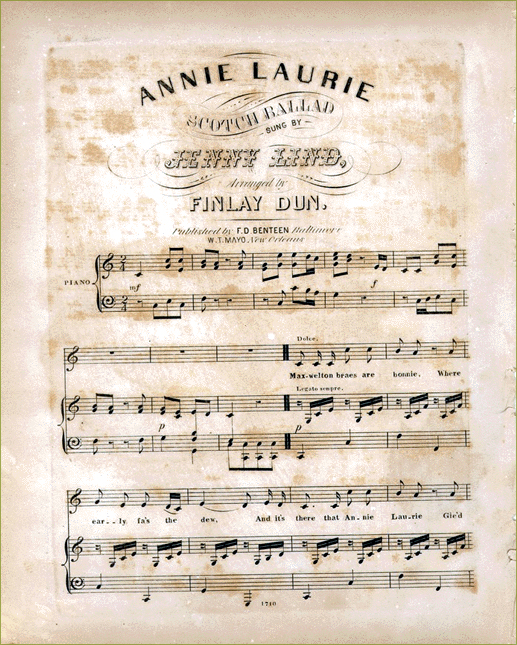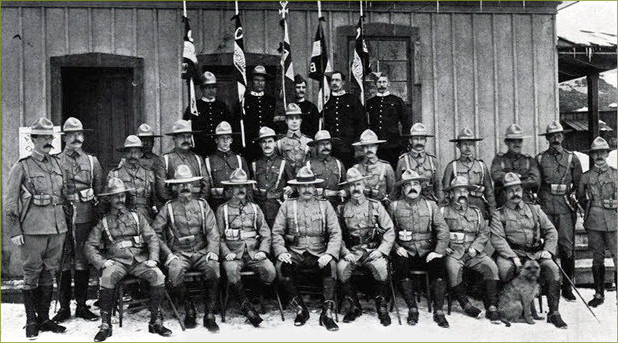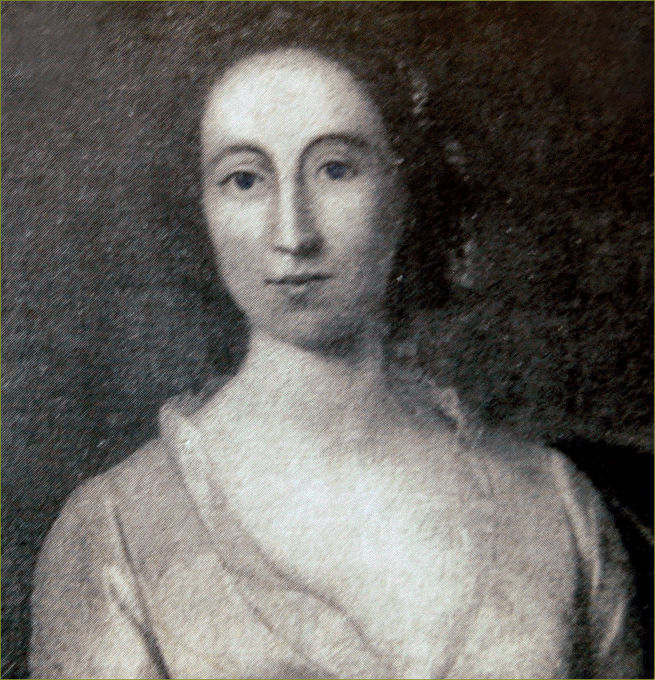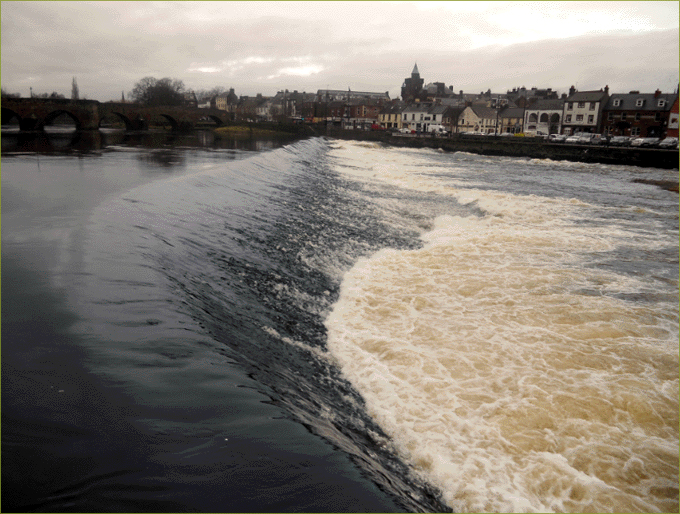

Annie Laurie is Coming to Founders Day
BY: BG EDITOR

Jul 01, 2017 — GREENWOOD, BC (BG)
"Annie Laurie" is an old Scottish song based on a poem believed to have been written by William Douglas (c. 1672—1748) of Dumfries and Galloway, about his heart's desire for the beautiful Annie Laurie. Music was later written for the poem by Lady John Scott, around 1835.
"Annie Laurie", also known as "Maxwelton Braes" was a favourite song in Greenwood at the turn of the century. It was sung here on a great many occasions — more often, it seems, than any other song performed in Greenwood during that period. In fact, it seems that nearly every time Annie Laurie was sung in Greenwood, an encore was demanded.
Annie Laurie was sung by the Greenwood Choral Society, by high school students, by tenor and mezzo-soprano soloists, both local and visiting, and by a male quartet at the smoking club. And this year, the song will be sung again in honour of Greenwood's 120th Anniversary, as part of the opening ceremonies at Founders Day.
The earliest known version of the song was published by James Lindsay of Glasgow, with these lyrics:
Maxwelton's braes are bonnie,
Where early fa's the dew,
Twas there that Annie Laurie
Gi'ed me her promise true.
Gi'ed me her promise true —
Which ne'er forgot will be,
And for bonnie Annie Laurie
I'd lay me down [doon] and dee.
Her brow is like the snaw-drift,
Her neck is like the swan,
Her face it is the fairest,
That 'er the sun shone on.
That 'er the sun shone on —
And dark blue is her e'e,
And for bonnie Annie Laurie
I'd lay me down and dee.
Like dew on gowans lying,
Is the fa' o' her fairy feet,
And like winds, in simmer sighing,
Her voice is low and sweet.
Her voice is low and sweet —
And she's a' the world to me;
And for bonnie Annie Laurie
I'd lay me down and dee.
Pronunciation:
braes (a brae is a sloping bank of river or seashore)
bonnie (pretty)
fa's (falls)
gi'ed (gave)
doon and dee (down and die)
snaw (snow)
e'e (eye)
gowans (daisies)
simmer (summer)
a (all)
bonnie (pretty)
fa's (falls)
gi'ed (gave)
doon and dee (down and die)
snaw (snow)
e'e (eye)
gowans (daisies)
simmer (summer)
a (all)
The first known performance of Annie Laurie in Greenwood was on April 21, 1897, when the piece was sung, and then reprised at a fund-raising concert to benefit Mr. H. M. Irwin, who was returning to Toronto to complete his course at the Theological College. Annie Laurie was sung and encored that night by C. Scott Galloway, the partner of Greenwood's founder, Robert Wood.
"On Wednesday night the schoolroom was crowded by a thoroughly appreciative audience on the occasion of the concert given by the ladies of Greenwood. … Annie Laurie was sung by Mr. Galloway."
A few years later Annie Laurie was sung again, this time by a famous American singer who gave a concert in Greenwood. Unfortunately the hall facilities were not up to snuff, as reported by the Greenwood Weekly Times, April 21, 1900:
BREHANY CONCERT
A High Class Entertainment in Miller's Hall Last Evening.
"Even a Louise M. Brehany could not arouse enthusiasm in Miller's hall. Its wretched acoustic properties and lack of proper ventilation would destroy proper appreciation on the part of even the most ardent lover of good music. … Blessed with a sweet mezzo-soprano voice of great power, a pleasant manner and a pretty face, she [Louise M. Brehany] immediately captures her audience. Her singing of "Could I," "Thine Forever" and "Annie Laurie," as an encore, made good the claim that she is one of America's greatest ballad singers."
A High Class Entertainment in Miller's Hall Last Evening.
"Even a Louise M. Brehany could not arouse enthusiasm in Miller's hall. Its wretched acoustic properties and lack of proper ventilation would destroy proper appreciation on the part of even the most ardent lover of good music. … Blessed with a sweet mezzo-soprano voice of great power, a pleasant manner and a pretty face, she [Louise M. Brehany] immediately captures her audience. Her singing of "Could I," "Thine Forever" and "Annie Laurie," as an encore, made good the claim that she is one of America's greatest ballad singers."
Just over a year later, Annie Laurie was again sung, this time as part of an important social gathering in Greenwood. The occasion, a "complimentary smoker" in honour of Greenwood's own Lieut. J. Edwards Leckie, D.S.O. (Distinguished Service Order), a Canadian serviceman who fought with the Strathcona Horse in the Boer War.
The event was described in the Greenwood Weekly Times, May 16, 1901. The mood of patriotism at this early Greenwood event makes it a fitting story to hear again on this, the 150th Anniversary of Canada's confederation.
LIEUT. LECKIE
ENTHUSIASTICALLY WELCOMED BY CITIZENS OF GREENWOOD. COMPLIMENTARY SMOKER.
In the Auditorium Monday Night. Presented With Gold Watch and Chain — Plenty Enthusiasm.
"There may be room for a few more people but none for further enthusiasm", said Mayor Jakes in his opening remarks at the complimentary smoker tendered to Lieut. J. Edwards Leckie, D. S. O., in. the Auditorium on Monday night. It is said that there is always room for one more and equally true is it that a little more in enthusiasm can be crowded in.
Before midnight the big crowd who started the evening in a most enthusiastic and patriotic frame of mind worked up to such a pitch that the rafters rang with shouts of welcome to the Greenwood hero who brought fame to the little city whence he went to fight the Empire's battles.
The committee in charge of the entertainment had the theatre appropriately decorated with flags and buntings. In a cosmopolitan city like Greenwood, their patriotism was not selfish and the Stars and Stripes were strung along side the Union Jack. Pictures of Lords Roberts and Kitchener were hung on the stage and some enthusiastic Irishman draped the former with 'the 'flag of the Emerald Land'. The box set aside for the guest of the evening was also suitably decorated.
In front, the letters D. S. O. paid eloquent tribute to the valor of the hero and the pride which those present felt, in one of their fellow citizens. The reception was not confined to Greenwood. Phoenix sent a strong delegation and Midway, Eholt and other surrounding districts were well represented."
ENTHUSIASTICALLY WELCOMED BY CITIZENS OF GREENWOOD. COMPLIMENTARY SMOKER.
In the Auditorium Monday Night. Presented With Gold Watch and Chain — Plenty Enthusiasm.
"There may be room for a few more people but none for further enthusiasm", said Mayor Jakes in his opening remarks at the complimentary smoker tendered to Lieut. J. Edwards Leckie, D. S. O., in. the Auditorium on Monday night. It is said that there is always room for one more and equally true is it that a little more in enthusiasm can be crowded in.
Before midnight the big crowd who started the evening in a most enthusiastic and patriotic frame of mind worked up to such a pitch that the rafters rang with shouts of welcome to the Greenwood hero who brought fame to the little city whence he went to fight the Empire's battles.
The committee in charge of the entertainment had the theatre appropriately decorated with flags and buntings. In a cosmopolitan city like Greenwood, their patriotism was not selfish and the Stars and Stripes were strung along side the Union Jack. Pictures of Lords Roberts and Kitchener were hung on the stage and some enthusiastic Irishman draped the former with 'the 'flag of the Emerald Land'. The box set aside for the guest of the evening was also suitably decorated.
In front, the letters D. S. O. paid eloquent tribute to the valor of the hero and the pride which those present felt, in one of their fellow citizens. The reception was not confined to Greenwood. Phoenix sent a strong delegation and Midway, Eholt and other surrounding districts were well represented."
At the event, "Messrs. Whiteside, Hodge, Smith and Harris sang Annie Laurie, their voices blending sweetly. They were enthusiastically encored as were all other numbers on the programme."
Pictured below are officers of the famed Strathcona Horse armoured regiment. On March 16, 1899 the force embarked on the S.S. Monterey, bound for duty in the Anglo Boer War. 28 officers and approx. 512 men in the ranks, with 599 horses, 3 maxims, 1 pom-pom, 500 rounds per rifle, and 50,000 rounds per maxim. The regiment landed at Cape Town on April 10th, having lost nearly 200 horses at sea.

Lord Strathcona Horse prior to heading to the Boer War, 1899
[ Photo: RCMP Strategic Partnerships and Heritage Branch ]
Just at the Irishman at Lieutenant Leckie's event was quick to drape the stage with the flag of his Emerald Isle, so Annie Laurie was commonly sung to assert Scottish pride. The April 14th, 1900 edition of the Greenwood Weekly Times reported on the spirited Liberal Convention that had taken place in Vancouver that week:
"9:00—The crowd on the platform became packed like sardines. A tall gentleman from Sooke attempted to sing an Irish song immediately in front of the chairman. He was drowned out by "Annie Laurie." Two other gentlemen nearly had a fight."
Less than a month after the smoker in honour of Lieutenant Leckie, Annie Laurie was sung once again, this time at the maiden concert of Greenwood's first choral society on June 5th, 1901. One member of the Greenwood Choral Society, Mrs. Mclnnes, (previously of Rossland), sang two verses of Annie Laurie as an encore, and her performance was described as "exceedingly good".
After a few years hiatus, Annie Laurie was next heard on the concert stage in November of 1908, when it was performed by high school students:
"The student's recitel given by Mrs. Murray's class in the Auditorium on Monday evening was much appreciated by all those who had the pleasure of being present. It was the first entertainment of the kind to be held in Greenwood and after the solo, "Annie Laurie," Mrs. Murray was presented with a beautiful boquet by the members of her class."
A few months later, a winter advertisement in the Boundary Creek Times heralded the approach of a local performance by soprano, Lena Duthie:
"The appealing tenderness of "Annie Laurie" has awakened nobelest emotions in thousands, under the spell of Lena Duthie's marvellous voice, and her rendition of "Loch Lomond," that song, unsurpassed in its beauty, among the songs of love and longing and the sadness of farewell has held vast audiences enraptured."
And last, we find this report from the Times on January 21, 1910, about a traveling motion picture show that was accompanied by live singers. These were silent films — 'talkies' didn't come available until 1927 — thus the live performers in the troupe, who added their voices like an 'audio track'.
THE TALKING PICTURES
"A bumper house greeted the first appearance of the Dreamland Theatre Co.'s Cromophone Talking pictures last week. The excellent entertainment afforded general satisfaction. The pictures were capital, and it is hard to realize that one is not actually viewing the originals, for every action was accompanied by a simultaneous vocal reproduction.
Thursday's evening's program comprised songs by Harry Lauder, Ada Jones and Len Spencer. In addition were four splendid reels of moving pictures. Miss Jean McKenzie sang sweetly and well, her voice being a well trained mezzo soprano, the singing of Annie Laurie called for a rousing encore.
E. R. Mack sang a capital illustrated song entitled "It Looks Like a Big Night Tonight," which was much enjoyed. The Dreamland Theatre Co. are leaving for a trip to the coast next week and will play a return engagement in Greenwood in about six weeks."
"A bumper house greeted the first appearance of the Dreamland Theatre Co.'s Cromophone Talking pictures last week. The excellent entertainment afforded general satisfaction. The pictures were capital, and it is hard to realize that one is not actually viewing the originals, for every action was accompanied by a simultaneous vocal reproduction.
Thursday's evening's program comprised songs by Harry Lauder, Ada Jones and Len Spencer. In addition were four splendid reels of moving pictures. Miss Jean McKenzie sang sweetly and well, her voice being a well trained mezzo soprano, the singing of Annie Laurie called for a rousing encore.
E. R. Mack sang a capital illustrated song entitled "It Looks Like a Big Night Tonight," which was much enjoyed. The Dreamland Theatre Co. are leaving for a trip to the coast next week and will play a return engagement in Greenwood in about six weeks."
The Life of Annie Laurie

Annie Laurie
From a portrait hanging at Maxwelton
Further details on the life of Annie Laurie are found on a family genealogy site:[1]
"Anna Laurie, or as she is known to the world, Annie Laurie was the fourth daughter of Sir Robert Laurie and Jean Riddell. It was Annie's romance with William Douglas of Fingland, which made her famous throughout the world. Douglas had a small estate near Craigdarroch, up the valley of Craigdarroch Water. Annie's father was a Royalist and a persecutor of the Covenanters, so it meant she had to meet her lover secretly on Maxwelton Braes. He was a hot-headed Jacobite and a supporter of the Stuarts."

Annie's birthplace — Barjarg Tower, Auldgirth, Scotland
According to Wikipedia, 'Annie Laurie was born Anna, on 16 December 1682, about 6 o'clock in the morning at Barjarg Tower, in Keir, near Auldgirth, Scotland, the youngest daughter of Robert Laurie, who became first baronet of Maxwellton in 1685.
Traditionally it is said that Douglas had a romance with Annie Laurie, but that her father opposed a marriage. This may have been because Anna was very young; she was only in her mid-teens when her father died. It may also have been because of Douglas's aggressive temperament or more likely because of his Jacobite allegiances.
It is known for certain that they knew of each because in a later letter by Anna she says in reply to news about Douglas, "I trust that he has forsaken his treasonable opinions, and that he is content."
William Douglas became a soldier in the Royal Scots and fought in Germany and Spain and rose to the rank of captain. He also fought at least two duels. He returned to his estate at Fingland in 1694.
Douglas recovered from this romance with Annie Laurie and eloped with a Lanarkshire heiress, Elizabeth Clerk of Glenboig. They married in Edinburgh in 1706. Douglas's political beliefs forced him into exile. He became a mercenary soldier and sold his estate at Fingland in the 1720s, though eventually he received a pardon.
In Edinburgh on 29 August 1709 Anna married Alexander Fergusson, 14th Laird of Craigdarroch. She lived at Craigdarroch for 33 years. She died on 5 April 1764, at Friars' Carse, Dumfriesshire, Scotland, and some sources say she was buried at Craigdarroch.
Portraits of her exist at Maxwelton and at Mansfield, the seat of the Stuart-Monteiths. The portraits show that she had blue eyes.'

Maxwelltown's Braes
Maxwelton's Bonnie Braes
Maxwelton (Maxwelltown) is situated in the county of Kirkcudbrightshire in southwest Scotland (now Dumfries). As noted above under the song lyrics, the reference to Maxwelton's "braes" refers to the sloping banks on the river shoreline. In the case of Maxwelton's braes were slopes on the banks of the Nith River, which flows through the center of town, with Maxelton on one side, and Whitesands on the other. This river flows down from the Carsphairn Hills of East Ayrshire, then then through to Dumfries and on to the sea.
While some Braes are naturally formed, the Maxwelton brae is created by a hand-made caul, which acts as a weir in the center of the river. It was built in 1705, and you can still see the bricks used to create it, for the purpose of directing water to a nearby mill.
We hope our readers will join us for Greenwood's 2017 Founders Day, and will enjoy hearing Greenwood's new choir, the G-Miners, sing a traditional version of Annie Laurie — perhaps for the first time in more than 100 years.
REFERENCES:
Boundary Creek Times — Apr 24, 1897, p. 3
Greenwood Weekly Times — Apr 14, 1900 p. 2
Greenwood Weekly Times — Apr 21, 1900, p. 1
Greenwood Weekly Times — May 16, 1901, p. 1
Greenwood Weekly Times — Jun 06, 1901, p. 1
Boundary Creek Times — Nov 20, 1908, p. 4
Boundary Creek Times — Feb 26, 1909, p. 4
Boundary Creek Times — Jan 21, 1910, p. 1
Wikipedia
FOOTNOTES:
[1] Bridge Famly Genealogy
http://wc.rootsweb.ancestry.com/cgi-bin/igm.cgi?op=GET&db=stanwardine&id=I156


